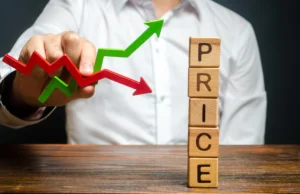Price gap analysis has become one of the most practical approaches for traders seeking profitable trades in 2025. When markets open with a sharp difference between the previous close and the new session’s open, a price gap forms. These gaps signal sudden shifts in sentiment, order flow, or even institutional activity. Smart traders rely on price gap analysis to gain an edge. In this article, you will discover proven gap trading strategies, gap fill techniques, and real examples for mastering trading market gaps and spotting winning gap and go setups.
What Is Price Gap Analysis, and Why Does It Matter?
Price gap analysis helps traders decode the language of the markets. A price gap occurs when an asset opens significantly higher or lower than its last closing price. This “jump” is visible as a blank space on the chart. Gaps happen in stocks at the market open, in forex after weekends, and often after important news or earnings.
Traders use price gap analysis because gaps can reveal momentum, exhaustion, or reversal. Some gaps fill quickly, while others run with the trend for powerful moves. Understanding which is which is the first step in any gap trading strategy.
For example, if a stock closes at 100 and opens at 105, that 5-point gap can offer both risks and opportunities. With proper price gap analysis, you can spot whether this is a gap-and-go setup with potential for further gains or if it is likely to reverse with a gap-fill technique.
Types of Price Gaps Every Trader Should Know
Not all gaps are created equal. Your approach to trading market gaps depends on the type of gap. The main types include:
- Common Gaps: These appear in quiet periods and usually fill quickly.
- Breakaway Gaps: These occur when price breaks out of a consolidation zone, often starting a new trend.
- Runaway Gaps: Found in the middle of strong trends, these show that momentum is accelerating.
- Exhaustion Gaps: These form at the end of trends and often signal that a reversal is near.
Knowing the difference is essential for choosing the right gap trading strategy. For instance, a breakaway gap often leads to a gap and go setup, while a common gap is a better candidate for a gap fill technique.
The Psychology Behind Trading Market Gaps
Trading market gaps is about reading crowd psychology. Gaps often reflect news shocks, institutional buying or selling, or mass fear and greed. When you see a gap, ask what might be causing it. Is there breaking news, a surprise earnings report, or sudden economic data?
For example, if a tech stock gaps up after better-than-expected results, the move is driven by optimism. Price gap analysis helps you decide whether to join the move or wait for a gap fill. By using trading market gaps in your routine, you can avoid emotional trades and stick to high-probability setups.
Gap Trading Strategy: Step-by-Step Approach
Successful traders use clear rules to guide their gap trading strategy. Here’s how you can apply price gap analysis for practical results:
- Identify the gap in your chosen timeframe. Look for significant size compared to average candles.
- Classify the gap: is it common, breakaway, runaway, or exhaustion?
- Check volume: High volume confirms conviction behind the gap. Low volume warns of a possible reversal.
- Wait for confirmation. Don’t jump in just because you see a gap. Let price and volume tell the story.
- Plan your entry and exit based on the gap type and overall market context.
For instance, in a gap and go setup, you look for strong volume and bullish continuation after an upward gap. In contrast, a gap fill technique focuses on signs of exhaustion or rejection after the gap, aiming to trade the return to the previous close.
How to Use the Gap Fill Technique for Reliable Results
The gap fill technique is one of the most popular strategies in price gap analysis. This method bets that the gap will “close” as the price retraces back to the previous day’s closing level.
To use this technique:
- Wait for confirmation that price is stalling after the initial gap move.
- Look for reversal candlesticks or momentum loss.
- Enter your trade in the direction of the fill.
- Set your stop just beyond the high or low of the gap.
- Target the previous close or just before for your exit.
For example, a stock opens lower on weak volume after no major news and immediately starts to reverse. The gap fill technique tells you to buy, aiming for the gap to close. Many traders prefer this approach for common or exhaustion gaps.
The Gap and Go Setup: Catching Big Moves Early
The gap and go setup is the opposite of the gap fill technique. Instead of betting on a reversal, you are looking for follow-through in the direction of the gap. This approach is common after strong news, earnings, or economic events.
Steps to trade a gap and go setup:
- Identify a large gap with strong news or fundamentals.
- Confirm that volume is much higher than usual at the open.
- Watch for bullish (or bearish) candles to confirm momentum.
- Enter the trade early, riding the continuation.
- Place your stop inside the gap area for protection.
In forex, this could mean entering a buy on EURUSD after a weekend gap up, especially if positive European economic data supports the move. In stocks, it may be buying a tech share after a breakout on strong earnings, using the gap and go setup for quick gains.
Risk Management When Trading Market Gaps
Trading market gaps can be highly profitable but also risky. Markets can move fast, and failed gap trades can result in rapid losses. Therefore, risk management is critical.
- Always use stop-loss orders to protect your account.
- Keep your position size smaller on gap trades, as volatility can spike.
- Do not chase gaps if you miss the first move. Wait for your setup.
- Diversify your trades and never risk too much on a single gap.
A well-executed gap trading strategy relies on strict discipline and a willingness to walk away if the setup is not perfect.
Real-Life Examples of Profitable Gap Trades
Let’s look at how price gap analysis plays out in real markets.
Example 1:
A popular biotech stock closes at $80 and opens at $88 after FDA approval news. Volume is extremely high, and price continues upward. Using the gap and go setup, you buy after the first bullish candle, set your stop just below the gap, and ride the momentum for a $6 gain.
Example 2:
A blue-chip stock closes at $120 and opens at $115 with no major news. The gap is small, and the opening candle quickly reverses with strong buying. Using the gap fill technique, you buy at $116, place a stop at $114, and take profit at $120 as the gap closes by midday.
Example 3:
In forex, GBPUSD opens Monday with a 60-pip gap down after weekend political drama. You see volume fading and reversal signals, so you use the gap fill technique for a buy. Price fills the gap by Tuesday’s London session, giving you a solid risk-reward trade.
Using Technology for Better Gap Trading in 2025
Modern traders use scanners, alerts, and automated tools to spot trading market gaps as soon as they happen. With advanced charting, you can set up alerts for gaps above a certain size or with high volume. Many platforms now include gap trading strategy templates and backtesting tools.
Backtesting your gap fill technique or gap and go setup is essential. Review historical performance, win rates, and risk profiles before risking real money. If you trade multiple assets, compare which stocks, forex pairs, or crypto tokens offer the cleanest gaps and most reliable fills.
Common Mistakes to Avoid in Price Gap Analysis
Even experienced traders make errors when trading market gaps. Some common mistakes include:
- Trading every gap without confirmation.
- Ignoring the difference between gap types.
- Over-leveraging positions on emotional moves.
- Failing to use stops or manage risk.
Avoid these pitfalls by sticking to your gap trading strategy and following a checklist before every trade. Patience and discipline are your best allies in price gap analysis.
Advanced Tips for Consistent Gap Trading Profits
- Combine gap analysis with other technical signals like support, resistance, and moving averages.
- Watch for gaps aligning with pre-market or after-hours news for extra conviction.
- Track historical gap fill statistics for your favourite assets to identify the best opportunities.
- Use smaller-sized and wider stops during periods of extreme market volatility.
Professional traders often blend gap and go setups with swing trading, allowing for partial profits as the move continues. They also monitor volume closely. Low volume increases the risk of fakeouts, while high volume supports momentum.
Conclusion:
Price gap analysis remains a vital tool for traders who want an edge in today’s fast-moving markets. Whether you use the gap fill technique, gap and go setup, or another gap trading strategy, understanding how to read and react to gaps is a must.
By focusing on trading market gaps with a clear plan, using real examples, and managing your risk, you can turn gaps from a source of confusion into a reliable source of profit. In 2025, as technology advances and markets evolve, the power of price gap analysis only grows. Add it to your trading playbook, and let the gaps work for you.
Read here to learn more about “Automated Pattern Recognition: How AI Changes Chart Analysis”.

I’m Chaitali Sethi — a seasoned financial writer and strategist specializing in Forex trading, market behavior, and trader psychology. With a deep understanding of global markets and economic trends, I simplify complex financial concepts into clear, actionable insights that empower traders at every level. Whether it’s dissecting winning strategies, breaking down market sentiment, or helping traders build the right mindset, my content bridges the gap between information and implementation.




